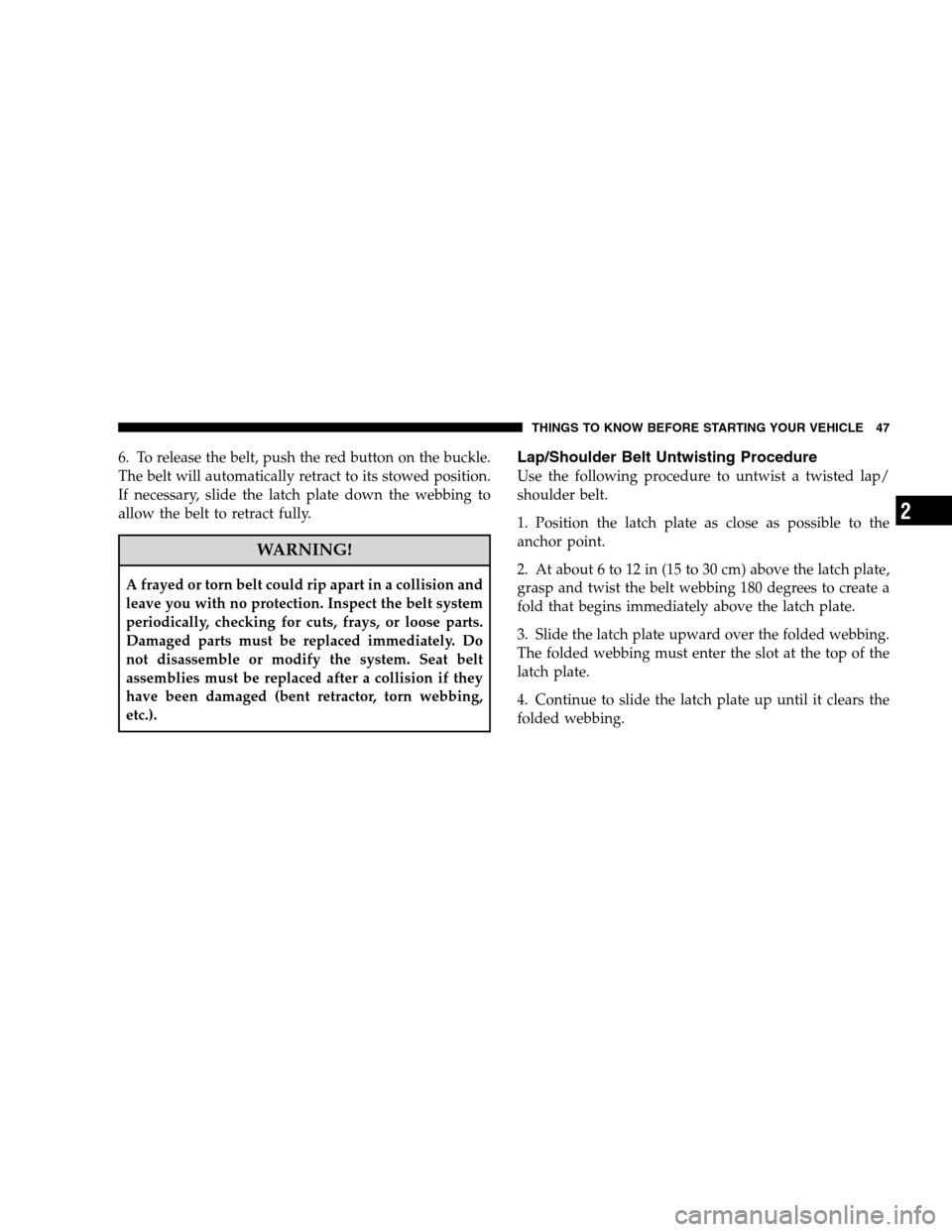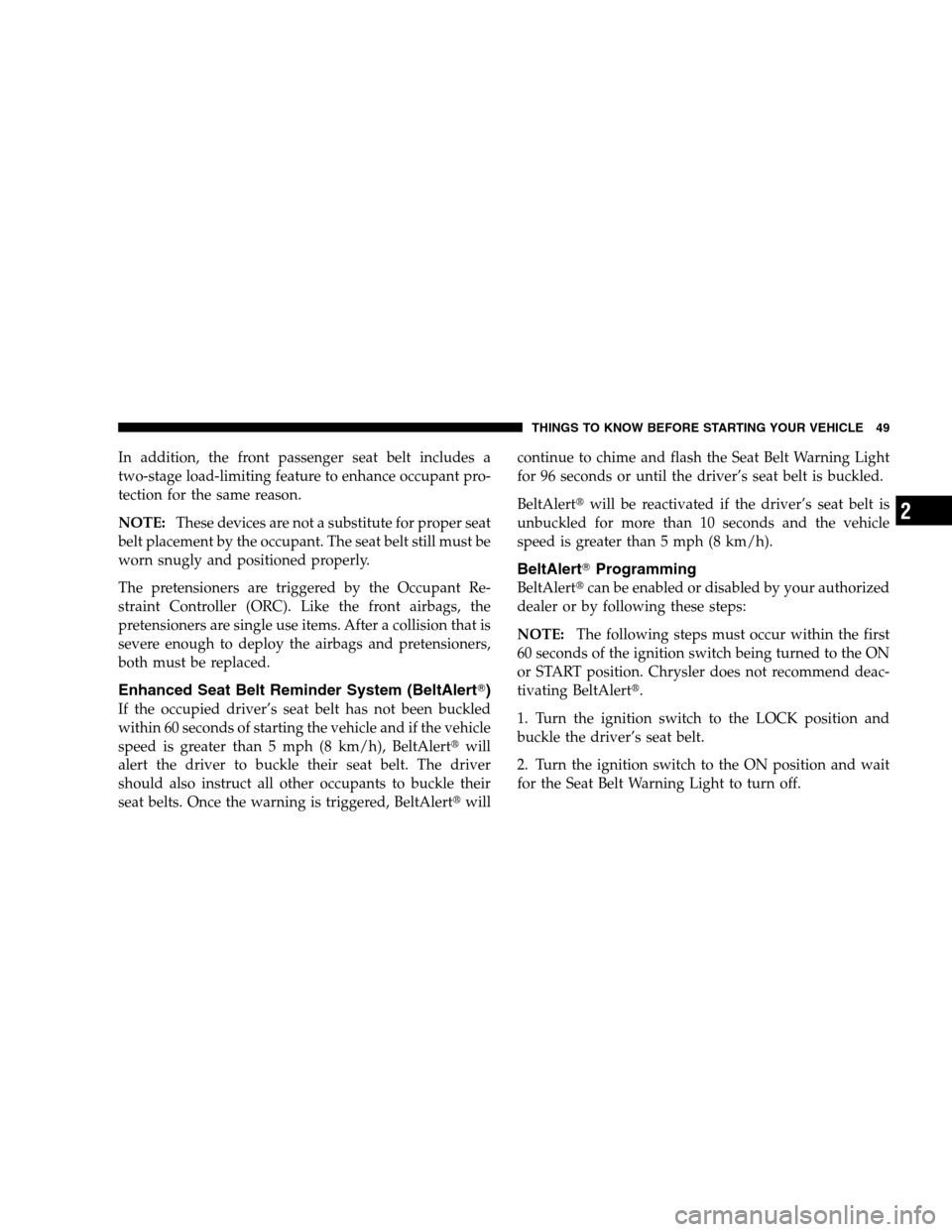Page 46 of 494
2. The seat belt latch plate is above the back of the front
seat, next to your arm. Grasp the latch plate and pull out
the belt. Slide the latch plate up the webbing as far as
necessary to allow the belt to go around your lap.3. When the belt is long enough to fit, insert the latch
plate into the buckle until you hear a “click.”
WARNING!
•A belt that is buckled into the wrong buckle will
not protect you properly. The lap portion could ride
too high on your body, possibly causing internal
injuries. Always buckle your belt into the buckle
nearest you.
•A belt that is too loose will not protect you as well.
In a sudden stop, you could move too far forward,
increasing the possibility of injury. Wear your seat
belt snugly.
Pulling Out the Latch Plate
44 THINGS TO KNOW BEFORE STARTING YOUR VEHICLE
Page 47 of 494
WARNING!
•A belt that is worn under your arm is very danger-
ous. Your body could strike the inside surfaces of the
vehicle in a collision, increasing head and neck
injury. A belt worn under the arm can cause internal
injuries. Ribs aren’t as strong as shoulder bones.
Wear the belt over your shoulder so that your stron-
gest bones will take the force in a collision.
•A shoulder belt placed behind you will not protect
you from injury during a collision. You are more
likely to hit your head in a collision if you do not
wear your shoulder belt. The lap and shoulder belt
are meant to be used together.
Inserting Latch Plate Into Buckle
THINGS TO KNOW BEFORE STARTING YOUR VEHICLE 45
2
Page 48 of 494
4. Position the lap belt across your thighs, below your
abdomen. To remove slack in the lap belt portion, pull up
on the shoulder belt. To loosen the lap belt if it is too tight,
tilt the latch plate and pull on the lap belt. A snug belt
reduces the risk of sliding under the belt in a collision.WARNING!
•A lap belt worn too high can increase the risk of
internal injury in a collision. The belt forces won’t be
at the strong hip and pelvic bones, but across your
abdomen. Always wear the lap belt as low as pos-
sible and keep it snug.
•A twisted belt can’t do its job as well. In a collision,
it could even cut into you. Be sure the belt is straight.
If you can’t straighten a belt in your vehicle, take it to
your authorized dealer and have it fixed.
5. Position the shoulder belt on your chest so that it is
comfortable and not resting on your neck. The retractor
will withdraw any slack in the belt.
Positioning the Lap Belt
46 THINGS TO KNOW BEFORE STARTING YOUR VEHICLE
Page 49 of 494

6. To release the belt, push the red button on the buckle.
The belt will automatically retract to its stowed position.
If necessary, slide the latch plate down the webbing to
allow the belt to retract fully.
WARNING!
A frayed or torn belt could rip apart in a collision and
leave you with no protection. Inspect the belt system
periodically, checking for cuts, frays, or loose parts.
Damaged parts must be replaced immediately. Do
not disassemble or modify the system. Seat belt
assemblies must be replaced after a collision if they
have been damaged (bent retractor, torn webbing,
etc.).
Lap/Shoulder Belt Untwisting Procedure
Use the following procedure to untwist a twisted lap/
shoulder belt.
1. Position the latch plate as close as possible to the
anchor point.
2. At about 6 to 12 in (15 to 30 cm) above the latch plate,
grasp and twist the belt webbing 180 degrees to create a
fold that begins immediately above the latch plate.
3. Slide the latch plate upward over the folded webbing.
The folded webbing must enter the slot at the top of the
latch plate.
4. Continue to slide the latch plate up until it clears the
folded webbing.
THINGS TO KNOW BEFORE STARTING YOUR VEHICLE 47
2
Page 51 of 494

In addition, the front passenger seat belt includes a
two-stage load-limiting feature to enhance occupant pro-
tection for the same reason.
NOTE:These devices are not a substitute for proper seat
belt placement by the occupant. The seat belt still must be
worn snugly and positioned properly.
The pretensioners are triggered by the Occupant Re-
straint Controller (ORC). Like the front airbags, the
pretensioners are single use items. After a collision that is
severe enough to deploy the airbags and pretensioners,
both must be replaced.
Enhanced Seat Belt Reminder System (BeltAlert�)
If the occupied driver’s seat belt has not been buckled
within 60 seconds of starting the vehicle and if the vehicle
speed is greater than 5 mph (8 km/h), BeltAlert�will
alert the driver to buckle their seat belt. The driver
should also instruct all other occupants to buckle their
seat belts. Once the warning is triggered, BeltAlert�willcontinue to chime and flash the Seat Belt Warning Light
for 96 seconds or until the driver’s seat belt is buckled.
BeltAlert�will be reactivated if the driver’s seat belt is
unbuckled for more than 10 seconds and the vehicle
speed is greater than 5 mph (8 km/h).
BeltAlert�Programming
BeltAlert�can be enabled or disabled by your authorized
dealer or by following these steps:
NOTE:The following steps must occur within the first
60 seconds of the ignition switch being turned to the ON
or START position. Chrysler does not recommend deac-
tivating BeltAlert�.
1. Turn the ignition switch to the LOCK position and
buckle the driver’s seat belt.
2. Turn the ignition switch to the ON position and wait
for the Seat Belt Warning Light to turn off.
THINGS TO KNOW BEFORE STARTING YOUR VEHICLE 49
2
Page 52 of 494

3. Within 60 seconds of turning the ignition switch to the
ON position, unbuckle and then re-buckle the driver’s
seat belt at least three times within 10 seconds, ending
with the seat belt buckled.
NOTE:Watch for the Seat Belt Warning Light to turn on
while unbuckling and off while re-buckling the seat belt.
It may be necessary to retract the seat belt partially each
time when unbuckling.
4. Turn the ignition switch to the LOCK position. A
single chime will sound to signify that you have success-
fully completed the programming.
BeltAlert�can be reactivated by repeating this procedure.
NOTE:Although BeltAlert�has been deactivated, the
Seat Belt Warning Light will continue to illuminate while
the driver’s seat belt remains unbuckled.Automatic Locking Mode
In this mode, the shoulder belt is automatically pre-
locked. However, the belt will still retract to remove any
slack in the shoulder belt. The Automatic Locking Mode
is available on all passenger-seating positions. Use the
Automatic Locking Mode anytime a child safety seat is
installed in a passenger seating position. Children 12
years old and younger should be properly restrained in
the rear seat whenever possible.
How to Engage The Automatic Locking Mode
1. Buckle the combination lap/shoulder belt.
2. Grasp the shoulder portion and pull downward until
the entire belt is extracted.
3. Allow the belt to retract. As the belt retracts, you will
hear a clicking sound. This indicates the safety belt is
now in the Automatic Locking Mode.
50 THINGS TO KNOW BEFORE STARTING YOUR VEHICLE
Page 53 of 494

How to Disengage the Automatic Locking Mode
Unbuckle the combination lap/shoulder belt and allow it
to retract completely to disengage the Automatic Locking
Mode and activate the vehicle sensitive (emergency)
locking mode.
Seat Belts And Pregnant Women
We recommend that pregnant women use the seat belts
throughout their pregnancy. Keeping the mother safe is
the best way to keep the baby safe.
Pregnant women should wear the lap part of the belt
across the thighs and as snug across the hips as possible.
Keep the belt low so that it does not come across the
abdomen. That way the strong bones of the hips will take
the force if there is a collision.
Seat Belt Extender
If a seat belt is too short, even when fully extended and
when the adjustable upper shoulder belt anchorage (if
equipped) is in its lowest position, your authorized
dealer can provide you with a seat belt extender. This
extender should be used only if the existing belt is not
long enough. When it is not required, remove the ex-
tender, and stow it.
WARNING!
Using a seat belt extender when not needed can
increase the risk of injury in a collision. Only use
when the lap belt is not long enough when it is worn
low and snug, and in the recommended seating
positions. Remove and store the extender when not
needed.
THINGS TO KNOW BEFORE STARTING YOUR VEHICLE 51
2
Page 58 of 494
NOTE:Airbag covers may not be obvious in the interior
trim; but they will open to allow airbag deployment.
The system includes sensors adjacent to both front and
rear seat occupants that are calibrated to deploy the side
bags during an impact severe enough to require airbag
occupant protection.
WARNING!
•Do not put anything on or around the airbag
covers or attempt to open them manually. You may
damage the airbags and you could be injured
because the airbags are not there to protect you.
These protective covers for the airbag cushions are
designed to open only when the airbags are inflat-
ing.
•Do not use accessory seat covers or place objects
between you and the side airbags; the performance
could be adversely affected and/or objects could
be pushed into you, causing serious injury.
Side Airbag Inflatable Curtains (SABIC) Location
56 THINGS TO KNOW BEFORE STARTING YOUR VEHICLE